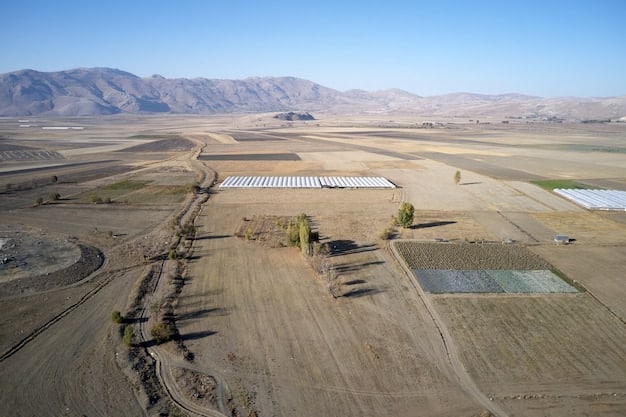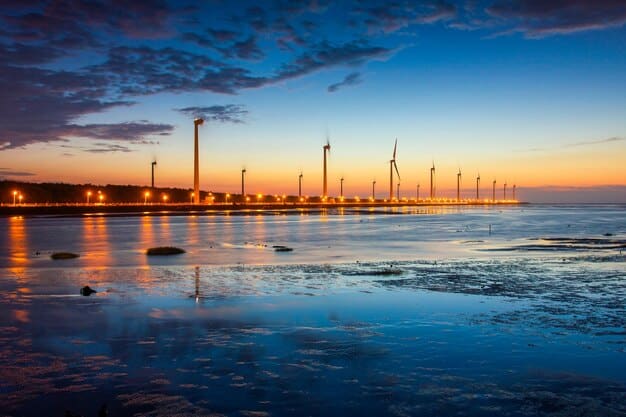Renewable Energy Innovations: Solar, Wind & Hydro Advancements in the US

Renewable energy technology in the US is rapidly evolving, with the latest innovations in solar, wind, and hydro power focusing on enhancing efficiency, reducing costs, and improving grid integration for a sustainable energy future.
The drive for sustainable energy solutions is fueling remarkable advancements in renewable energy technology across the United States. From cutting-edge solar panels to innovative wind turbine designs and enhanced hydropower systems, discover how these breakthroughs are shaping a cleaner, more efficient energy landscape in the US.
Renewable Energy Technology: Solar Power Innovations in the US
Solar energy is experiencing a boom in innovation, with new technologies making it more accessible and efficient than ever. In the United States, solar power is becoming a cornerstone of the renewable energy mix, driven by groundbreaking research and development.
Perovskite Solar Cells
Perovskite solar cells represent a significant leap forward in solar technology. These cells offer the potential for higher efficiency and lower manufacturing costs compared to traditional silicon-based solar panels.
Here’s why perovskites are gaining so much attention:
- Higher Efficiency: Perovskite cells can achieve higher power conversion efficiencies, meaning they can convert a greater percentage of sunlight into electricity.
- Lower Cost: The materials used in perovskite cells are less expensive than silicon, potentially leading to significantly lower manufacturing costs.
- Flexibility: Perovskite materials can be deposited on flexible substrates, opening up possibilities for new applications like flexible solar panels and coatings.
Researchers in the US are actively exploring the development and commercialization of perovskite solar cells, with the goal of making solar energy even more competitive with fossil fuels.

Bifacial Solar Panels
Bifacial solar panels are designed to capture sunlight from both the front and back surfaces, increasing energy production compared to traditional single-sided panels.
Key benefits of bifacial solar panels include:
- Increased Energy Yield: By capturing sunlight from both sides, bifacial panels can generate significantly more electricity.
- Improved Performance in Snowy Conditions: The rear-facing side can capture reflected sunlight from snow, enhancing energy production during winter months.
- Enhanced Durability: Some bifacial panel designs offer improved durability and resistance to degradation.
The adoption of bifacial solar panels is growing rapidly in the US, particularly in utility-scale solar projects, where the increased energy yield can significantly improve project economics.
In conclusion, solar energy technology is continuously evolving with innovations like perovskite cells and bifacial panels. These advancements are not only improving efficiency but also lowering costs, contributing to the broader adoption of solar power across the United States and solidifying its place as a key player in the renewable energy sector.
Wind Power: Advanced Turbine Technology
Wind power is another critical component of the renewable energy landscape in the US. Recent innovations in wind turbine technology are focused on increasing energy capture and reducing the environmental impact of wind farms.
Larger and More Efficient Turbines
One of the key trends in wind power is the development of larger and more efficient turbines. These turbines feature longer blades and taller towers, allowing them to capture more wind energy.
Here’s a look at the advantages of larger turbines:
- Increased Energy Production: Larger blades sweep a greater area, capturing more wind energy and generating more electricity.
- Improved Capacity Factors: Taller towers allow turbines to access stronger and more consistent winds, improving their capacity factors (the percentage of time they operate at full capacity).
- Reduced Costs: While larger turbines require a greater upfront investment, they can generate more electricity over their lifespan, leading to lower levelized cost of energy (LCOE).
The latest generation of wind turbines is pushing the boundaries of engineering, with some turbines now exceeding 800 feet in height.
Floating Offshore Wind Farms
Floating offshore wind farms are a promising technology for harnessing wind energy in deepwater locations where traditional fixed-bottom turbines are not feasible. These farms use floating platforms to support the turbines, allowing them to be deployed in areas with higher wind speeds and less visual impact.
Key benefits of floating offshore wind farms include:
- Access to Untapped Wind Resources: Floating platforms open up access to vast offshore wind resources in deepwater locations.
- Reduced Visual Impact: By locating turbines further offshore, the visual impact on coastal communities can be minimized.
- Scalability: Floating platforms can be scaled up to support larger and more powerful turbines.
The first commercial-scale floating offshore wind farms are now being developed in the US, paving the way for significant expansion of offshore wind power.

Advancements in wind turbine technology, such as larger, more efficient designs and floating offshore wind farms, are revolutionizing the energy sector. The United States is poised to capitalize on these innovations, increasing wind energy production and moving closer to a sustainable energy future. By optimizing turbine size and harnessing offshore wind resources, the US can further integrate wind power into its energy mix.
Hydro Power: Enhancing Efficiency and Sustainability
Hydropower is a well-established renewable energy source in the US, and ongoing innovations are focused on enhancing its efficiency, sustainability, and environmental compatibility.
Pumped Storage Hydropower
Pumped storage hydropower (PSH) is a technology that uses two reservoirs at different elevations to store and generate electricity. During periods of low demand, water is pumped from the lower reservoir to the upper reservoir. When demand is high, the water is released from the upper reservoir to the lower reservoir, generating electricity as it flows through turbines.
The benefits of PSH include:
- Energy Storage: PSH provides a reliable and cost-effective way to store large amounts of electricity.
- Grid Stabilization: PSH can quickly respond to changes in demand, helping to stabilize the grid and integrate intermittent renewable energy sources like solar and wind.
- Ancillary Services: PSH can provide ancillary services such as frequency regulation and voltage support, further enhancing grid reliability.
New PSH projects are being developed across the US to support the growth of renewable energy and improve grid resilience.
Low-Impact Hydropower Technologies
Low-impact hydropower technologies are designed to minimize the environmental impact of hydropower projects. These technologies include run-of-river hydropower, which does not require large reservoirs, and fish-friendly turbines, which reduce the risk of fish mortality.
Key features of low-impact hydropower include:
- Reduced Environmental Impact: By minimizing the size of reservoirs and using fish-friendly turbines, low-impact hydropower can reduce the impact on aquatic ecosystems.
- Improved Public Acceptance: Low-impact hydropower projects are often more widely accepted by the public due to their reduced environmental impact.
- Sustainable Energy Production: Low-impact hydropower can provide a sustainable source of electricity while preserving the ecological integrity of rivers and streams.
The development and deployment of low-impact hydropower technologies are crucial for ensuring that hydropower remains a sustainable and environmentally responsible energy source in the US.
Innovations in hydropower, like pumped storage and low-impact technologies, aim to increase efficiency and minimize environmental effects. The United States continues to leverage hydro power by enhancing grid stability through energy storage solutions and promoting eco-friendly methods to preserve aquatic ecosystems while generating sustainable energy.
The Role of Energy Storage
Energy storage is becoming increasingly important for integrating renewable energy sources into the grid. Energy storage systems can store excess electricity generated by solar and wind power plants and release it when demand is high, helping to balance supply and demand and improve grid reliability.
Battery Energy Storage Systems (BESS)
Battery energy storage systems (BESS) are a key component of modern energy storage solutions. BESS can quickly store and release electricity, making them ideal for short-term energy storage applications, such as frequency regulation and peak shaving.
The advantages of BESS include:
- Fast Response Time: BESS can respond to changes in demand within milliseconds, providing critical grid stabilization services.
- Scalability: BESS can be scaled up or down to meet specific energy storage needs.
- Location Flexibility: BESS can be located at various points on the grid, from utility-scale power plants to residential homes.
The deployment of BESS is growing rapidly in the US, driven by declining battery costs and increasing demand for grid stability.
Other Energy Storage Technologies
In addition to BESS, other energy storage technologies are also being developed and deployed, including:
- Compressed Air Energy Storage (CAES): CAES uses compressed air to store energy, which can be released to drive turbines and generate electricity.
- Thermal Energy Storage (TES): TES uses heat or cold to store energy, which can be used for heating, cooling, or electricity generation.
- Hydrogen Energy Storage: Hydrogen energy storage involves producing hydrogen from excess renewable energy, which can be stored and used to generate electricity or power vehicles.
These technologies offer unique advantages and are being explored for a variety of energy storage applications.
The integration of energy storage solutions is vital for the effective use of renewable sources. Technologies like Battery Energy Storage Systems offer swift responses and scalability, while other methods such as Compressed Air, Thermal, and Hydrogen Energy Storage provide diverse options. By implementing these storage solutions, the electrical grid gains enhanced stability and is better equipped to manage the fluctuating energy supplies from renewable sources.
Smart Grids and Grid Modernization
Smart grids are advanced electricity networks that use digital technology to improve the efficiency, reliability, and security of the power grid. Grid modernization efforts are focused on upgrading existing grid infrastructure and deploying new technologies to support the integration of renewable energy and enhance grid resilience.
Advanced Metering Infrastructure (AMI)
Advanced metering infrastructure (AMI) is a key component of smart grids. AMI systems use smart meters to collect and transmit data on electricity consumption, allowing utilities to better monitor and manage the grid.
The benefits of AMI include:
- Improved Grid Visibility: AMI provides utilities with real-time data on electricity consumption, allowing them to identify and respond to grid problems more quickly.
- Demand Response: AMI enables demand response programs, which incentivize consumers to reduce their electricity consumption during peak periods.
- Energy Efficiency: AMI provides consumers with detailed information on their energy consumption, helping them to identify ways to save energy.
AMI systems are being deployed across the US as part of grid modernization efforts.
Grid Management Systems
Grid management systems are software platforms that allow utilities to monitor and control the power grid. These systems use advanced algorithms and data analytics to optimize grid operations, improve reliability, and integrate renewable energy sources.
Key features of grid management systems include:
- Real-Time Monitoring: Grid management systems provide real-time monitoring of grid conditions, allowing operators to quickly identify and respond to problems.
- Advanced Control Algorithms: These systems use advanced algorithms to optimize grid operations and improve efficiency.
- Renewable Energy Integration: Grid management systems can help to integrate renewable energy sources into the grid by forecasting renewable energy production and managing grid stability.
The deployment of grid management systems is critical for ensuring that the power grid can handle the increasing penetration of renewable energy.
The modernization of electrical grids is essential for enabling the effective integration of renewable energy sources. Advanced Metering Infrastructure enhances grid transparency, enabling utilities to optimize energy distribution and promote energy efficiency. Additionally, modern Grid Management Systems play a crucial role in streamlining grid operations, bolstering reliability, and assimilating sustainable energy sources effectively to support a more resilient and eco-friendly energy infrastructure.
Policy and Investment in Renewable Energy
Government policies and investments play a crucial role in driving the deployment of renewable energy technologies. Supportive policies, such as tax credits, renewable energy mandates, and carbon pricing, can create a level playing field for renewable energy and incentivize investment.
Federal Tax Credits
Federal tax credits, such as the Investment Tax Credit (ITC) for solar energy and the Production Tax Credit (PTC) for wind energy, have been instrumental in driving the growth of renewable energy in the US. These credits reduce the cost of renewable energy projects, making them more competitive with fossil fuels.
The impact of federal tax credits includes:
- Reduced Project Costs: Tax credits can significantly reduce the upfront cost of renewable energy projects, making them more attractive to investors.
- Increased Deployment: Tax credits incentivize the deployment of renewable energy technologies, leading to increased capacity and electricity generation.
- Job Creation: The renewable energy industry is a major source of job creation, and tax credits help to support the growth of this industry.
The continuation and expansion of federal tax credits are crucial for sustaining the growth of renewable energy in the US.
State Renewable Energy Mandates
State renewable energy mandates, also known as renewable portfolio standards (RPS), require utilities to generate a certain percentage of their electricity from renewable sources. These mandates create a guaranteed market for renewable energy and drive investment in renewable energy projects.
Key aspects of state renewable energy mandates include:
- Guaranteed Market: RPS mandates create a guaranteed market for renewable energy, reducing the risk for investors.
- Increased Investment: These mandates incentivize investment in renewable energy projects, leading to increased capacity and electricity generation.
- Reduced Emissions: By increasing the percentage of electricity generated from renewable sources, RPS mandates help to reduce greenhouse gas emissions.
Many states have adopted ambitious renewable energy mandates, driving significant growth in renewable energy deployment.
Government policies and strategic investments are crucial for accelerating the adoption of renewable energy technologies. Federal tax incentives, such as the Investment Tax Credit and Production Tax Credit, have significantly enhanced the viability of renewable projects. Likewise, state-level Renewable Portfolio Standards are essential in creating predictable markets for renewable energy, effectively driving investment and reducing emissions. The ongoing support and enhancement of these initiatives are vital for sustaining the growth and integration of renewable energy in the United States.
| Key Point | Brief Description |
|---|---|
| ☀️ Solar Innovations | Perovskite & bifacial panels enhance efficiency & lower costs. |
| 💨 Wind Advancements | Larger turbines & floating offshore farms access more wind. |
| 💧 Hydro’s Future | Pumped storage & low-impact tech improve sustainability. |
| 🔋 Energy Storage | Batteries & other storage integrate renewables into the grid. |
FAQ
▼
Perovskite solar cells are an emerging type of solar cell that uses perovskite-structured compounds as the light-absorbing material. They offer potential advantages such as higher efficiency and lower production costs than traditional silicon-based cells.
▼
Bifacial solar panels are designed to capture sunlight from both the front and back sides of the panel. This allows them to generate more electricity compared to traditional monofacial panels, which only capture sunlight from one side.
▼
Pumped storage hydropower (PSH) is a type of hydroelectric energy storage. It works by pumping water from a lower reservoir to a higher reservoir during periods of low electricity demand, and then releasing the water back down to generate electricity during peak demand.
▼
A smart grid is an advanced electricity network that uses digital technology to improve the efficiency, reliability, and security of the power grid. It incorporates technologies like smart meters and advanced grid management systems.
▼
Renewable portfolio standards (RPS) are state mandates that require utilities to generate a certain percentage of their electricity from renewable sources. These standards help drive investment in renewable energy projects.
Conclusion
The landscape of renewable energy technology in the US is marked by continuous innovation across solar, wind, and hydro power. From advanced solar cells and larger wind turbines to enhanced hydropower systems and energy storage solutions, these developments are essential for creating a sustainable energy future. With supportive policies and ongoing investments, the United States is poised to lead the way in renewable energy technology, paving the path towards a cleaner, more resilient, and environmentally friendly energy sector.





